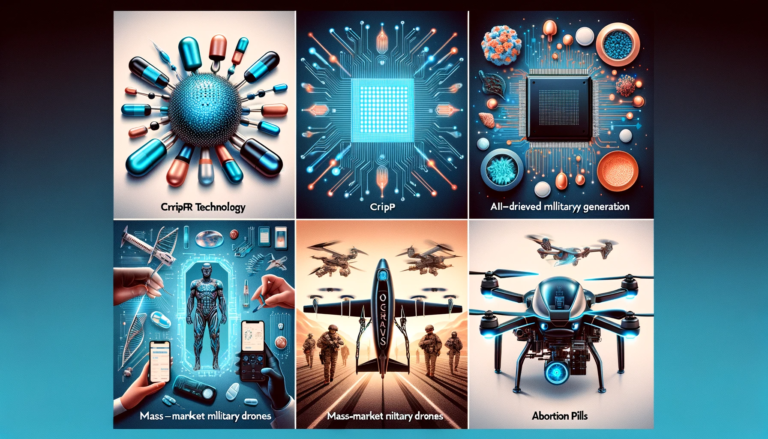Imagine stepping into a world where tiny technologies create huge waves of change. This is the story of innovative microtechnology, a realm where marvels are not just imagined, but made real. In this vibrant narrative, innovative microtechnology plays the hero, transforming everything from medicine to art, and even warfare.
It's like witnessing a series of exciting episodes, each showcasing how innovative microtechnology reshapes our world in its own unique way. From the precision of CRISPR tackling high cholesterol, to the magic of AI in art, the journey of innovative microtechnology is filled with awe-inspiring chapters. As we embark on this exploration, let's discover how innovative microtechnology is not just a part of our story, but is becoming the storyteller itself, weaving new possibilities into the fabric of our daily lives. Now, let's explore these innovative microtechnologies and unveil their fascinating stories!
CRISPR: Innovative microtechnology
CRISPR, a remarkable example of innovative microtechnology, is revolutionizing the way we approach healthcare. This technology, akin to molecular scissors, allows for precise gene editing, making significant strides in treating conditions like high cholesterol. Imagine being able to alter genetic makeup to combat such common health issues. CRISPR's introduction into mainstream medicine is a game-changer, offering hope for more effective treatments and possibly even cures for a range of genetic diseases. This innovative microtechnology isn't just an advancement; it's a transformative force in the world of medicine.

Here's a simple breakdown of how it works
Parts of CRISPR
It has two main parts: a guide RNA and a special protein called Cas. The RNA guides the system to the right spot in the DNA.
- Targeting Genes: CRISPR can turn off certain genes. It finds the right spot on the DNA to do this.
- How It Works: The Cas protein cuts the DNA where the RNA guides it. This cut can change how the gene works.
- Fixing the Cut: After cutting, the cell fixes the DNA. How it's fixed can change the gene in different ways.
- Making It Precise: Scientists have made CRISPR more accurate to avoid changing the wrong parts of DNA.
- Exact Changes: CRISPR can be used to make very specific changes in DNA, like correcting a single mistake.
- Editing Without Cutting: There's a way to use CRISPR to edit DNA without making a big cut, which can be safer.
- Turning Genes On or Off: CRISPR can also be used to control if a gene is active or not.
CRISPR is a powerful tool in innovative microtechnology, offering new ways to understand and treat diseases.
AI Image Generation
The second exciting technology in our exploration of innovative microtechnology is AI-driven image generation. This technology is transforming the creative and commercial world by turning simple text phrases into stunning visual art. Here's a simple breakdown of this innovative microtechnology

- AI Image Generation: Companies like OpenAI, Stability AI, Midjourney, and Google have developed AI models that can create images from text descriptions. This means you can type a description of almost anything, and these programs will create a picture of it.
- Key Developments: OpenAI's DALL-E, launched in 2021, was a significant step in this field. It was followed by an improved version, DALL-E 2, in 2022. Google also introduced its own AI for image creation, Imagen.
- Stable Diffusion: A major breakthrough came with Stable Diffusion, an open-source model released by Stability AI. It stands out for its ability to produce high-quality images and its compatibility with home computers.
- Impact and Accessibility: By making these tools accessible to everyone, Stability AI has fueled a surge in creativity and innovation. Millions have created images using these tools, demonstrating their widespread appeal and impact.
- Beyond Images: The technology is now being integrated into software like Photoshop and is used by visual-effects artists and video-game studios to streamline their work. Moreover, the technology is evolving towards generating video content as well.
AI image generation represents a major advancement in innovative microtechnology, blending creativity with technology to reshape how we create and interact with visual content.
RISC-V
RISC-V is an innovative microtechnology that functions as an open-source architecture for chip design. It provides a set of instructions that tell the hardware how to execute tasks, making it highly adaptable and efficient for various applications.
The flexibility of RISC-V allows for customization and optimization, which is crucial for specific needs in industries like aerospace, AI/ML, automotive, and more. Its open-source nature means that anyone can contribute to and improve upon the RISC-V design, fostering a diverse and collaborative community. This approach has led to rapid advancements and widespread adoption of RISC-V in the microtechnology sector.

This technology is making significant strides in 2023 and has several key features and achievements:
- Growing Adoption: RISC-V has been integrated into over 13 billion cores worldwide, reflecting its growing influence and adoption across various sectors. The RISC-V community now spans over 4,100 members across 70 countries, driving standards, software, and tools development.
- New Specifications: In 2023, RISC-V ratified 16 new specifications, including the RISC-V Profiles specification version 1.0 with RVA20, RVI20, and RVA22, RISC-V Cryptography Extensions Volume II, and the RISC-V IOMMU Architecture Specification.
- Developer Support: RISC-V has expanded support for developers with the launch of RISC-V Labs, providing resources for building and testing software. Development boards like SiFive Unmatched, Starfive VisionFive V2, BeagleV®-Ahead, Sophgo Pioneer Boxes, and QWERTY Embedded Design ICE-V have been made more accessible.
- Innovations at RISC-V Summit: The RISC-V Summit in North America showcased the latest innovations, including Meta's development of video transcoders, inference accelerators, and training chips using RISC-V. Qualcomm announced shipping one billion devices with RISC-V microcontrollers, and Samsung discussed exploring RISC-V SoC design verification and application processors for the mobile market.
- Wide Variety of Products: RISC-V based products such as smartwatches, tablets, laptops, remote control cars, and developer boards were displayed, demonstrating the technology's versatility.
- Educational Resources: RISC-V Learn Online programs now offer certification options, and RISC-V Technical Sessions have been launched for in-depth learning about various RISC-V technologies.
- Community Building: The RISC-V community has been actively engaging in activities like career fairs, mentorship programs, and hackathons to foster growth and engagement in the RISC-V ecosystem.
RISC-V's open-source architecture and its rapidly growing ecosystem highlight its significance as an innovative microtechnology in the chip design industry.
Mass-market military drones
Mass-market military drones, a pivotal innovative microtechnology, have transformed modern warfare. These drones, varying from affordable quadcopters to more sophisticated models like the Bayraktar TB2, are used for a range of missions from reconnaissance to targeted strikes. Their cost-effectiveness and ease of operation have democratized aerial combat, making advanced drone technology accessible to a wider array of countries and groups.

This accessibility means that military strategies and capabilities around the world are being reshaped, as these drones offer significant tactical advantages in various combat scenarios.
- Broad Use and Impact: Previously, high-end drones like the American Predator and Reaper dominated drone warfare. However, recent conflicts, notably in Ukraine, have seen the widespread use of more affordable drones from countries like China, Iran, and Turkey. This shift has altered how drone combat is conducted and expanded the range of entities that can engage in it.
- Types of Drones: The market includes various types of drones. Off-the-shelf quadcopters, such as those made by DJI, are used for reconnaissance and close-range attacks. Meanwhile, drones like the Iranian-made Shahed, costing around $30,000, are capable of longer-range missions.
- Bayraktar TB2: A standout example is the Bayraktar TB2, priced at about $5 million and manufactured by Turkey's Baykar corporation. The TB2 is notable for its combination of efficient components in a slow-flying frame. It can travel up to 138 miles per hour, has a communication range of about 186 miles, and can stay aloft for 27 hours. Equipped with cameras for video sharing and laser-guided bombs, the TB2 is a versatile tool in modern warfare.
- Accessibility: One key aspect of the TB2, and similar drones, is their availability. Unlike costlier and more restricted US-made drones, these are accessible to a broader range of countries and groups.
- Global Usage: The TB2 has seen use in various conflicts around the world, including in Libya, Syria, Ethiopia, and by Azerbaijan during its war against Armenia. Ukraine also utilized these drones in the Donbas region and against Russian forces in 2022.
These mass-market military drones, with their affordability and capability, represent a significant development in innovative microtechnology, reshaping modern military strategy and capabilities.
Abortion pills via telemedicine
The provision of abortion pills via telemedicine represents a groundbreaking shift in healthcare, especially in the realm of reproductive rights. This innovative microtechnology allows individuals to access necessary medication for abortion remotely, bypassing traditional in-person consultations.
Particularly in regions where access to abortion care is limited, telemedicine offers a discreet and accessible way to obtain these pills, underscoring the profound impact of innovative microtechnologies in addressing critical healthcare needs. This approach has become a vital resource, ensuring continued access to reproductive healthcare services amidst changing legal landscapes.

The fifth innovative microtechnology we're discussing is the provision of abortion pills via telemedicine. This technology has become increasingly important, especially in the United States, where access to abortion care has seen significant changes:
- Telemedicine for Abortion Care: During the pandemic in 2021, the US Food and Drug Administration allowed healthcare providers to mail two pills, mifepristone and misoprostol, which can induce an abortion when taken together. By the end of 2021, this decision was made permanent.
- Increasing Demand: After the US Supreme Court ruled that abortion is not a constitutional right in 2022, demand for abortion pills surged. Nonprofits and startups began assisting patients in obtaining these pills. The process typically involves signing up, consulting with a medical provider via video call, text, or app, and then receiving the prescribed pills by mail.
- Challenges and Solutions: Access to medication abortion varies by state law in the US. Some organizations can ship pills to any state, while others follow state laws, which can be restrictive in certain areas. Despite these challenges, these organizations have been crucial in providing needed care.
- FDA's 2023 Update: In January 2023, the FDA announced that it would permit online and brick-and-mortar retail pharmacies to dispense abortion pills to patients with a prescription, potentially expanding access in states that allow it.
This innovative microtechnology represents a significant shift in how healthcare, particularly abortion care, is accessed and delivered, offering a discreet and accessible option for those in need.
What is CRISPR and how does it work in gene editing?
CRISPR is a powerful tool for editing genes, allowing scientists to make precise changes to DNA. It uses a guide RNA to target specific genes and a Cas protein to make cuts or alterations in the DNA.
How do AI-driven image generation technologies create artwork from text?
These technologies use advanced algorithms to interpret text descriptions and translate them into visual images, creating artwork based on the input phrases.
What makes RISC-V chip design innovative and different?
RISC-V is an open-source architecture for chip design, offering customizable and efficient instruction sets for various applications. Its adaptability and community-driven development make it a groundbreaking approach in chip technology.
How have mass-market military drones changed modern warfare?
Affordable and accessible, mass-market military drones have democratized aerial combat, allowing a wider range of countries and groups to deploy advanced drone technology for reconnaissance and targeted strikes.
What role does telemedicine play in providing abortion pills?
Telemedicine enables the remote consultation and prescription of abortion pills, making access to abortion care more discreet and accessible, especially in regions with restrictive laws or limited healthcare facilities.




